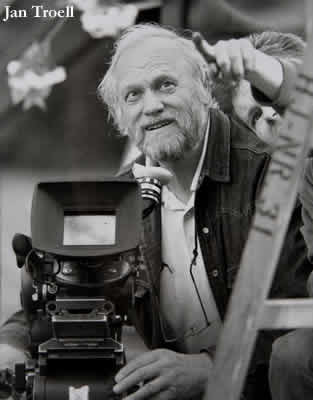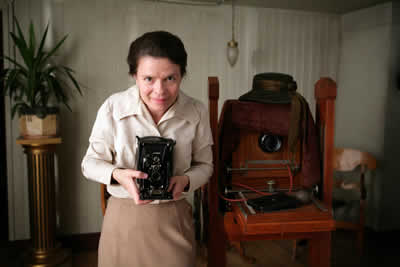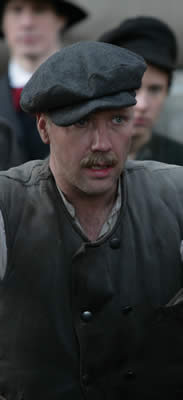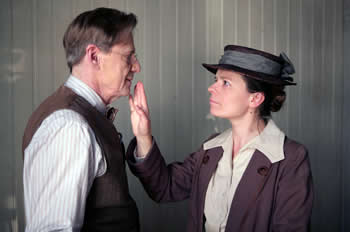Based on a true story, EVERLASTING MOMENTS explores the complexities of the marriage between Maria (Maria Heiskanen) and Sigfrid Larsson (Mikael Persbrandt), who wed in 1907 and soon had a houseful of children. Sigfrid, a dockworker, alcoholic and womanizer, leaves the worries of family responsibilities to Maria, who one day goes to hock an old camera that she won in a lottery but has never used. Encouraged by the obviously smitten camera shop owner (Jesper Christensen), Maria begins taking and developing photographs, a process that is forever miraculous to her. While she possesses an obvious “gift for seeing,” accumulated family events force her to ignore her craft, until she learns, slowly, the balance between her art and her life. It is a feat, Troell suggests, that is as miraculous as the capturing of images on film.
During his distinguished career, Swedish filmmaker Jan Troell has received myriad international accolades including an Oscar nomination for Best Director (THE EMIGRANTS, 1971) and three Academy Award nominations for Best Foreign Language Film (THE EMIGRANTS, 1972’s THE NEW LAND and 1982’s FLIGHT OF THE EAGLE). THE EMIGRANTS, starring Liv Ullman and Max Von Sydow, won Golden Globe Awards for Best Foreign Language Film and Best Actress, and earned five Oscar nominations  including Best Picture, Director, Actress and Adapted Screenplay in 1973. The film’s sequel, THE NEW LAND, a sweeping account of Swedish immigrants coming to America in the 1840s, was also nominated for an Oscar and won the Golden Globe Award for Best Foreign Language Film. His other films include SAGOLANDET (1986), IL CAPITANO (1991, winner of the Silver Bear in Berlin), and the acclaimed HAMSUN (1996), starring Max Von Sydow.
including Best Picture, Director, Actress and Adapted Screenplay in 1973. The film’s sequel, THE NEW LAND, a sweeping account of Swedish immigrants coming to America in the 1840s, was also nominated for an Oscar and won the Golden Globe Award for Best Foreign Language Film. His other films include SAGOLANDET (1986), IL CAPITANO (1991, winner of the Silver Bear in Berlin), and the acclaimed HAMSUN (1996), starring Max Von Sydow.
Bijan Tehrani: How did you encounter this story? Was it adapted from a book?
Jan Troell: No. It comes from interviews that my wife made during a six year period with a distant relative of hers. It was the eldest daughter of Maria Larsson. Her name is Maja, and she is in the film too. She lived until she was 92 years old. During her last six years my wife interviewed her and recorded it all. Maria Larsson was my wife’s-grandfather’s sister. The film takes place during the first years of the previous century.
BT: Did you have visual references? Were there pictures that you could use?
JT: Yes. We had quite a lot of photographs. My wife used this material to write a book, which was published a year ago. The book contains much more material than the film does, but the film is based off of some of that material. So, the book and the film both have the same source, but the film is not an adaptation of a book.
BT: Did the fact that you are also a cinematographer play a role in how you picked up this subject?
JT: Yes, I’m sure it did. I was only 14 years old when I started photographing, and I used a closet in my parents’ house for developing and printing. So, I knew a little of the mystery and miracle of making pictures in the same way that Maria must have. I am sure that this was part of my fascination with this story, but that was not the only thing; it was also the characters and the story. And, to some extent, it was the working class  surroundings. I grew up with a father who was a dentist in a working class area, and most of my friends were working class boys. For many years, I thought I would one day come back to this and make a film about my surroundings during my childhood.
surroundings. I grew up with a father who was a dentist in a working class area, and most of my friends were working class boys. For many years, I thought I would one day come back to this and make a film about my surroundings during my childhood.
BT: The actors in this film make it quite believable. I felt as though I was watching a documentary from the time period. How was the work relationship between you and your actors? Did you leave them to their own devices, or were you more precise in guiding them through the scenes?
JT: Well, I am very glad that you feel this way. This is always very important for me, to make it believable. I usually give the actors a lot of freedom, and if I have something to add, I do that. In this case I gave the actors the opportunity to read a lot of the background material. My wife had written down the transcripts of all the interviews, so I could give the actors access to these, as well as the photographs. I think this helped them to identify with the characters.
BT: How did you create the visual style of the film?
JT: For me it came naturally, because I wanted to have a realistic visual style. For instance, I chose deliberately to use super 16 negatives instead of 35. The producer offered me 35mm, but I chose 16mm because 35mm can be almost too perfect, in a way. I like the texture a little more grained in the image. 16mm cameras are also easier to carry around, and you can work a bit faster. We had 16mm negatives, and from that we made digital negatives for the 35mm prints. I would have liked to do the film in black and white, but that is not possible for commercial reasons anymore; there is almost no producer who will allow you to do that. But I thought we should eliminate as much color as possible from the clothes and so on. When we made the digital negatives, we changed colors as much as possible.
BT: What was the most challenging aspect in making this film?
JT: For me, almost always, the most challenging thing is to not compromise too much. I feel that every day during shooting I have to compromise, because of the limits of time and money. I would prefer to have much more time for shooting, so I have to decide on what—and when—I should give up and just compromise. This is the most difficult thing for me during shooting.
BT: When a story takes place over a long period of time, like two or three decades, it is very hard to maintain continuity. It is really hard to do it well, but you pull this off so nicely in this film and the time periods blend together very well.
JT: Well, of course you have to be aware of these things. With the children for example, we had to use seventeen different children to show the different ages of each child. But we did not do a lot of changes in makeup.
BT: This film has a very poetic feel. It remains with you for a long time. It’s just like one of the pictures taken by Maria. How have audience reactions been to this film so far?
JT: I have actually been overwhelmed by the reactions of audiences all over the world. The film has now been shown in South Korea, Germany, the United States and the Scandinavian countries. I have been present at a lot of those  screenings, and I also have gotten reactions from fans that have sent letters. It seems to be almost the same reaction everywhere. They have identified with these people, and have strong feelings for them. I am not sure why this is the case, but I think a lot depends on the actors; they are so believable.
screenings, and I also have gotten reactions from fans that have sent letters. It seems to be almost the same reaction everywhere. They have identified with these people, and have strong feelings for them. I am not sure why this is the case, but I think a lot depends on the actors; they are so believable.
BT: Any future projects?
JT: At the moment, I am working on a script with a Danish writer, whom I worked with on a film some years ago called “The Flight of the Eagle”. It is a film based on a real person, a Swedish Newspaper man during the Second World War. He was fighting against Hitler and the Nazis in the Swedish press from the beginning of the war to the end. He dedicated his life to fight against the Nazis in Sweden. In a way he became a threat to Swedish neutrality, because the government was fearful that Hitler would become so enraged over his writing that he would attack Sweden. For some years at the beginning of the war, there were several times when we were almost drawn into the war.

